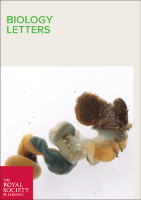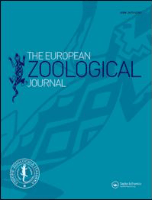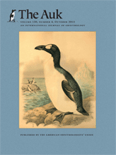
Avian Biology Research
Scope & Guideline
Unveiling the wonders of avian life.
Introduction
Aims and Scopes
- Ecology and Behavior:
Research in this area focuses on the ecological roles of birds, their behaviors, and how these are influenced by environmental factors. This includes studies on foraging behaviors, habitat use, and seasonal migrations. - Conservation Biology:
The journal publishes studies aimed at understanding the threats to bird populations, including habitat loss, climate change, and human impacts. This includes research on endangered species and conservation strategies. - Physiology and Morphology:
This includes investigations into the physiological adaptations of birds, such as metabolic responses to environmental stressors, reproductive physiology, and morphological variations across species. - Genetics and Evolution:
Research exploring the genetic diversity within avian species, evolutionary adaptations, and phylogenetic relationships is a core focus, providing insights into species conservation and management. - Human-Bird Interactions:
The journal covers studies on how human activities affect bird populations, including urban ecology and the impact of anthropogenic food sources on avian health and behavior.
Trending and Emerging
- Impact of Climate Change:
Recent papers increasingly address how climate change affects avian migration patterns, breeding success, and habitat use, emphasizing the urgent need for research in this area given global environmental changes. - Urban Ecology and Adaptation:
There is a growing focus on how birds adapt to urban environments, including studies on feeding behaviors and habitat preferences in urban settings, reflecting broader societal interest in wildlife conservation in human-dominated landscapes. - Genomics and Molecular Biology:
The integration of genomics into avian research is on the rise, with studies exploring genetic diversity and adaptations at the molecular level, which are crucial for understanding evolutionary processes and conservation genetics. - Behavioral Ecology:
An increasing number of studies are examining complex behavioral patterns in birds, such as courtship displays and social interactions, highlighting the importance of behavior in ecological and evolutionary contexts.
Declining or Waning
- Avian Diseases and Health:
Research related to avian diseases, while still important, has seen a decline, possibly due to a shift towards more ecological and behavioral studies as researchers focus on broader ecological impacts. - Traditional Taxonomy and Classification:
There has been a noticeable decrease in papers focusing solely on taxonomic revisions and descriptions. This may reflect a growing trend towards integrative approaches that combine genetics and ecology over traditional classification. - Morphometrics and Body Measurements:
Studies that solely focus on morphometric analyses without ecological context seem to be waning, as more researchers are integrating these measurements into broader ecological or behavioral studies.
Similar Journals

Biology Letters
Innovating the intersection of biology and interdisciplinary research.Biology Letters, published by the esteemed Royal Society, stands at the forefront of research in the field of biological sciences, with a strong emphasis on innovative studies that bridge gaps across disciplines. Since its inception in 2005, the journal has garnered significant recognition, achieving a remarkable Q1 ranking in Agricultural and Biological Sciences (miscellaneous) and a percentile of 88th in the same category, according to Scopus rankings. Released in the United Kingdom, the journal offers a platform for authors to share concise research findings and theoretical perspectives that contribute meaningfully to the advancement of biological inquiry. Although not open access, the journal remains highly regarded in the academic community for its rigorous peer-review process and impactful content, making it an invaluable resource for researchers, professionals, and students dedicated to exploring the complexities of biology. With an ongoing commitment to excellence, Biology Letters continues to shape the future of biological sciences.

Avian Conservation and Ecology
Connecting science and policy for avian conservation.Avian Conservation and Ecology, published by the Resilience Alliance, is a premier open-access journal dedicated to advancing the scientific understanding and management of avian populations and their ecosystems. With an ISSN of 1712-6568, this journal has been a vital resource since its inception in 2005, ensuring that research findings are readily accessible to the global community. Based in Canada, it covers a diverse array of topics within the realms of Animal Science, Zoology, Ecology, and Conservation. Recognized for its rigor, it boasts a distinguished Q1 ranking in Animal Science and Zoology, and maintains respectable positions in various ecological categories as of 2023. Researchers and students alike will find valuable insights and innovative studies that address key conservation challenges, reflecting the journal's commitment to fostering ecological resilience and informing policy-making. As a platform that champions open access, Avian Conservation and Ecology plays a crucial role in enhancing collaboration and communication among scientists, policy-makers, and the public。

CANADIAN JOURNAL OF ZOOLOGY
Empowering the Study of Life Through Comprehensive ResearchWelcome to the Canadian Journal of Zoology, a leading academic journal in the fields of Animal Science and Zoology as well as Ecology, Evolution, Behavior and Systematics. Published by Canadian Science Publishing since 1965, this esteemed journal serves as a vital platform for researchers, professionals, and students to disseminate and engage with significant findings in zoological and ecological research. With an impact factor placing it in the Q2 category and rankings reflecting its influence (201/490 in Animal Science and Zoology; 372/721 in Ecology), the journal is committed to advancing the understanding of animal biology and environmental interactions. Although currently not an open access publication, it provides comprehensive resources and studies that are crucial for the academic community. Based in Ottawa, Canada, the journal continues to push the boundary of knowledge right up to 2024 and beyond, making it an essential resource for anyone dedicated to the life sciences.

MALIMBUS
Deepening understanding of bird species and their ecosystems.MALIMBUS is a peer-reviewed journal published by the West African Ornithological Society, focusing on the study of avian biology and conservation. It aims to disseminate important research findings that contribute to the understanding of bird species, their habitats, and the challenges they face across West Africa and beyond. Although currently not available in an open-access format, the journal is an invaluable resource for ornithologists, ecologists, and industry professionals keen on advancing their understanding of avian science. Those engaged in research on bird migration, breeding behaviors, and conservation strategies will find MALIMBUS to be a vital platform for sharing innovative ideas and fostering collaborations. With its commitment to quality and rigorous review processes, MALIMBUS is an essential reference for anyone dedicated to studying and preserving avian diversity.

Ornithology Research
Pioneering Discoveries in Ecology and Avian ConservationOrnithology Research is a leading academic journal published by SPRINGERNATURE, specializing in the field of avian studies and contributing to the broader category of Animal Science and Zoology. With a respectable Q2 ranking in its field as of 2023, this journal provides a dynamic platform for the dissemination of innovative research findings related to ornithology, ecology, and conservation. The journal, which transitioned to an Open Access model, ensures that its research is accessible to a global audience, fostering collaboration and knowledge sharing across disciplines. With an E-ISSN of 2662-673X, Ornithology Research serves the needs of researchers, professionals, and students dedicated to understanding the complexities of avian life. Its commitment to high-impact, peer-reviewed articles makes it an essential resource for anyone interested in advancing the science of ornithology.

Journal of Vertebrate Biology
Fostering academic discourse on vertebrate evolution.Journal of Vertebrate Biology, a reputable publication established by the Institute of Vertebrate Biology in the Czech Republic, serves as a vital platform for research across the fields of Animal Science and Zoology, Aquatic Science, and Ecology, Evolution, Behavior and Systematics. With its ISSN 2694-7684 and a commendable 2023 Q2 ranking in multiple categories, this open-access journal embraces innovative scientific inquiry and fosters academic discourse. The journal's commitment to disseminating high-quality research is reflected in its Scopus rankings, positioning it within the top quartile in several impactful areas. As it continues to converge its focus until 2024, researchers, professionals, and students alike are encouraged to engage with cutting-edge studies that advance our understanding of vertebrate biology. This publication stands out not only in its scholarly contributions but also in enhancing global awareness of biodiversity and conservation issues.

JOURNAL OF ZOOLOGY
Advancing knowledge in animal biology and ecology.JOURNAL OF ZOOLOGY, published by Wiley, stands as a premier scholarly journal in the fields of Animal Science and Zoology, renowned for its outstanding contributions to the knowledge of animal biology and ecology. With an impressive impact factor and a strong ranking in the Q1 category for Animal Science and Zoology, as well as Q2 for Ecology, Evolution, Behavior, and Systematics, the journal rigorously engages with both foundational research and groundbreaking discoveries since its inception in 1830. Located in Hoboken, New Jersey, this journal is dedicated to fostering the academic community's understanding of zoological sciences, providing access to important research that shapes wildlife conservation efforts and ecological studies. Although the journal does not currently offer open access options, it continues to attract significant attention, as evidenced by its strong Scopus rankings in related categories. Researchers, professionals, and students will find invaluable resources in the JOURNAL OF ZOOLOGY to advance their understanding of animal life and the ecological challenges it faces today.

European Zoological Journal
Connecting Research and Conservation for a Sustainable FutureEuropean Zoological Journal, published by Taylor & Francis Ltd, is an esteemed open-access publication dedicated to advancing the exciting field of zoology. Since its inception in 2017, this journal has progressively established itself as a vital resource for researchers, professionals, and students alike. With its Q2 ranking in Animal Science and Zoology as of 2023, the journal ranks in the 69th percentile among its peers, showcasing its influence and contribution to the discipline. The journal’s broad scope covers a wide range of topics within zoology, aiming to foster an understanding of animal biology and conservation efforts. As an open-access journal, it not only enhances the dissemination of knowledge but also encourages collaborative research across global communities. Situated in the United Kingdom, the European Zoological Journal invites submissions that contribute to the evolving discourse in animal sciences, and endeavors to support the scientific community in addressing pressing ecological challenges.

Ornithology
Innovating Research in Avian Ecology.Ornithology, published by Oxford University Press Inc, is a premier journal dedicated to the field of avian biology, offering a platform for researchers, professionals, and students to share groundbreaking findings in the study of birds. With an impressive impact factor and ranking in the Q1 quartile for both Animal Science and Zoology, as well as Ecology, Evolution, Behavior, and Systematics, Ornithology serves as a vital resource for advancing our understanding of avian species and their ecological roles. The journal allows open access viewing, broadening the reach and impact of published research. Covering comprehensive studies from 1982 to 2023, it facilitates collaboration and innovation within the global ornithological community. Engaging with Ornithology not only elevates your research profile but also contributes to the rich tapestry of knowledge concerning the world's diverse bird populations.

JOURNAL OF ORNITHOLOGY
Exploring the Wonders of Avian LifeJOURNAL OF ORNITHOLOGY, published by Springer Heidelberg, is a leading international journal dedicated to the study of birds and their conservation. With an ISSN of 2193-7192 and an E-ISSN of 2193-7206, this journal serves as a crucial platform for disseminating innovative research focused on avian biology, ecology, and behavior, making significant contributions to the fields of Agricultural and Biological Sciences and Animal Science and Zoology, where it holds a commendable rank of #156 out of 490 in Scopus. Established from 2004 and continuing through 2024, the journal strives not only to advance academic scholarship but also to inform practical conservation efforts globally. While currently not open access, it remains a vital resource for researchers, professionals, and students seeking high-quality studies and findings that influence the understanding and preservation of bird species. The journal's commitment to excellence in science highlights its importance in ornithological research, offering insights that are both profound and actionable.